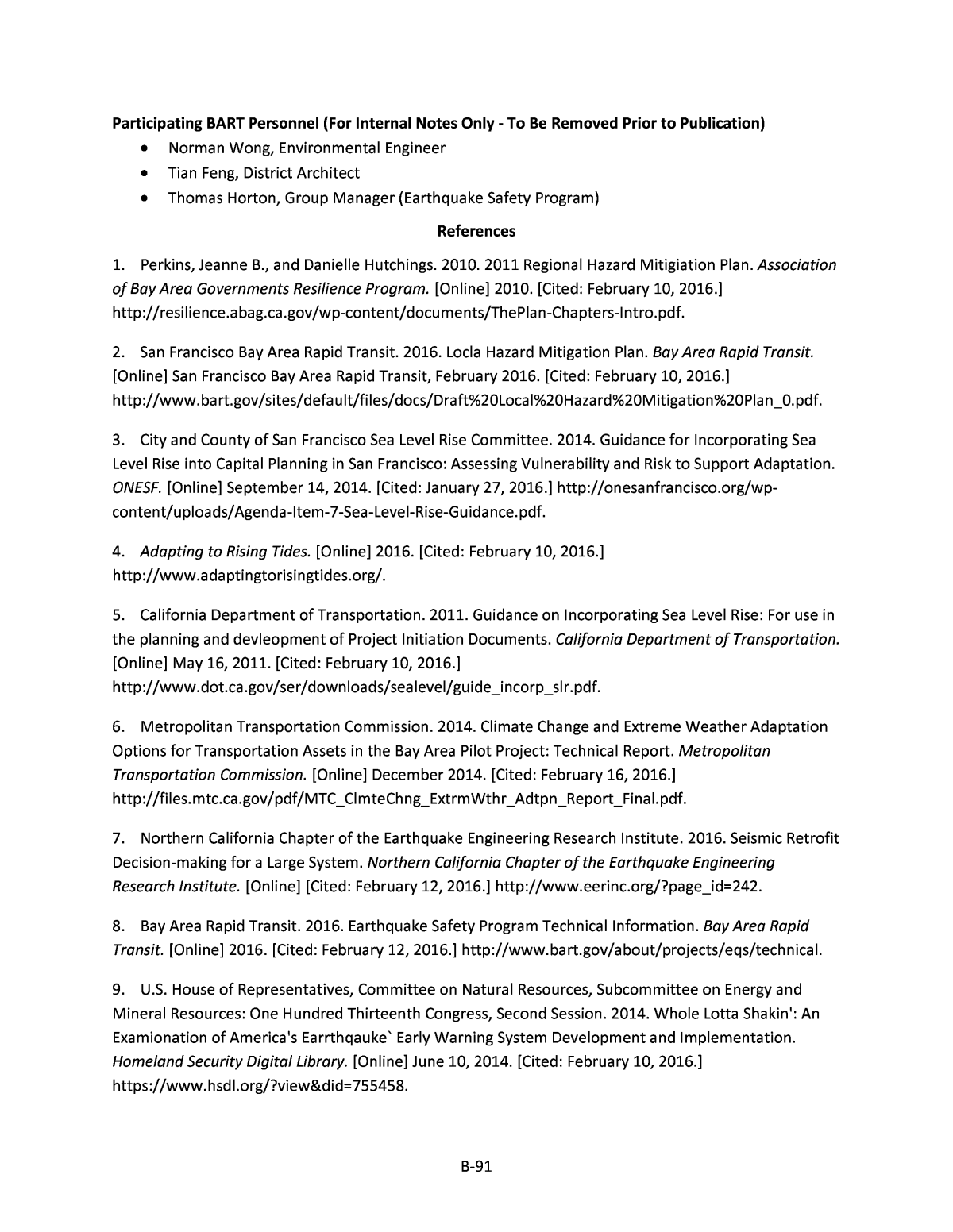







Below is the uncorrected machine-read text of this chapter, intended to provide our own search engines and external engines with highly rich, chapter-representative searchable text of each book. Because it is UNCORRECTED material, please consider the following text as a useful but insufficient proxy for the authoritative book pages.
Bâ84 San Francisco Bay Area Rapid Transit (BART) Case Study: San Francisco, CA Highlights:  BARTâs resilience efforts date back several decades to the Northridge Earthquake (1994).  More recently the agency has begun to broaden its focus to include resilience to extreme weather and climate change. Research over the past several yearsâincluding as part of the FTA Climate Change Adaptation pilot programâregarding vulnerability of BART assets and infrastructure to natural hazards and sea level rise provided a basis for obtaining the support of senior management at the agency to pursue strategies aimed at extreme weather resilience in addition to earthquake safety.  The agencies 20 years of experience retrofitting existing and building new infrastructure to withstand seismic threats is providing a strong foundation for its climate adaptation efforts and consideration of weatherârelated resilience in its policies, planning, capital programming, project design and construction activities.  BART is also an active participant in regional planning efforts aimed at addressing the threat of sea level rise in the San Francisco Bay Area.  Key Resiliency DriversÂ ï· State and local emphasis on resiliency; ï· FTA Pilot Studyâs identification of vulnerabilities; ï· Extreme weather events; and ï· Local, regional and state resiliency activities. Key Successes Earthquake Safety ProgramÂ ï· Obtaining public support to seek approval of bond issuance to pay for earthquake safety upgrades. ï· Implementation of a complete earthquake resiliency program including a comprehensive vulnerability assessment, development and evaluation of adaptation strategies, and full implementation of a capital improvement program to retrofit the transit system to increase resiliency against the hazard. ï· Establishing a process to allow for variances from seismic design criteria that does not compromise infrastructure performance during an earthquake. ï· Incorporation of earthquake resiliency into agency through seismic design standards. Climate AdaptationÂ ï· Obtaining leadership support on current and future climate adaptation and resiliency efforts. ï· Effectively communicated risks to executive leadership to drive resiliency funding decisions.
Bâ85 Key Lessons LearnedÂ ï· There is a need for a robust understanding of risk through understanding asset vulnerability to and impact from hazards to be able to incorporate policies and promote projects within an agency. Agencies will rely on the best available science provided at the local or regional level. ï· Regional coordination will be key in addressing sea level rise flooding issues where adaptations can occur beyond the transit agencyâs property boundary. ï· Public outreach and education may improve public support for resiliency programs. Agency Details Geographic Location West Coast Modes Operated HR Vehicles Operated [all modes](2013) 534 Annual Unlinked Trips (2013) 126,546,495 Hazards Earthquake, Sea Level Rise, Flooding, High Winds, Tsunami, Landslides, Wildfire, Drought, Heat Background:  Established through the State Legislature in 1951, plans were developed for the original BART system between 1957 and 1961.  After plan changes and challenges, construction began in 1964 with first rail service beginning in 1972. As part of the original system, BART completed the Transbay Tube in 1969, which saw revenue service begin in 1974 In 1989, the San Francisco area was hit by the Loma Prieta earthquake. Major damage to BARTâs infrastructure was avoided, resulting in an influx of BART commuters.  The month following the earthquake, BART hit new ridership records providing a critical service link during the closure of the Bay Bridge.   With the passing of each earthquake, including those outside of the greater San Francisco Bay Area such as the Northridge Earthquake in 1994, many changes to the seismic design and subsequent building codes occurred.  As knowledge and technology advances, the need for continual updates to resiliency efforts should as well.  In the 1990âs, a series of studies were conducted identifying that aerial structures were at risk to a major earthquake.  The USGS predicted at least one more major earthquake will hit the region in the next 30 years. It was at this point a seismic retrofit program was proposed. In 2000, the Earthquake Safety Program was established and continues today focusing on retrofitting the system with updated design standards to increase resiliency.  San Francisco itself has been at the forefront of addressing climate change, specifically sea level rise.  In 2010, local, state and federal agencies were brought together to collaborate and understand the effects of flooding along the coast in the San Francisco Bay Area.  The program, Adapting to Rising Tides (ART) continues to provide tools and support for resiliency planning in the region (1). In 2011, the agency was one of eight transit systems to be funded through the FTA to conduct a climate change adaptation pilot study.  This study allowed BART to evaluate its infrastructure against the risk and threats to the system, develop adaptation strategies to address at risk infrastructure, and link thoseÂ
Bâ86 strategies to the organizational structure and activities.  Today, BART is continuing their efforts to address both seismic resiliency and climate change resiliency. In a followâup study to the FTA Pilot Project, BART participated and supported the development of the âClimate Change and Extreme Weather Adaptation Options for Transportation Assets in the Bay Area Pilot Project: Technical Report (6).â Outlined within the report is guidance for conducting an assessment of infrastructure in the Bay Area as well as guidance on mainstreaming climate change within transportation decision making.  This guidance may support transit agencies as they fully integrated resiliency into their organization.  Beginning in 2015, San Mateo County began the process of conducting a vulnerability study, which BART has engaged the county on. Policy and Administration Climate Adaptation The State of California along with regional stakeholders has been and continues to be proponents of resiliency and climate change adaptation.  This state and local level emphasis on resiliency has allowed BART and its leadership to respond inâkind and begin to support efforts in addressing resiliency.  After completion of the FTA Pilot Study, staff was able to effectively communicate the findings of the study to department leads and executive management.  As a result, senior level staff recognized the importance to expand on the original study to include additional vulnerability assessments and other work.  This recognition led senior management and the BART Board of Directors to approve agency funding for FY15â16 to continue work on resiliency and adaptation. Internal efforts are currently focused on continued assessment and work around flooding vulnerabilities from the agencyâs train control system.  The train control system will be modernized in the coming years and the additional funding will look at best adaptation strategies to protect the capital investment.  Additionally, BART is directing efforts to incorporate climate change impacts, and more specifically sea level rise, into the update of the Local Hazard Mitigation Plan (LHMP) (1) [Note: The 2016 draft plan is available (2)]. Related, BART is also working to solidify its sustainability program.  Further highlighting the agencyâs leadership in support of future resiliency work, the sustainability program will be built with input and direction from top leadership.  Although a specific policy has not been adopted by BART on resiliency and/or climate change adaptation, it is fully anticipated that this will become one area of focus for the sustainability program. Externally, the San Francisco Bay Conservation and Development Commission (BCDC) has adopted policies that require sea level rise risk assessments to be completed when planning within shoreline areas.  Projects must be designed to cope with expected sea level rise impacts for the lifetime of the design. (3) BCDC provides guidance to increase resilience to sea level rise and storm events through a collaborative project with Bay Area communities called âAdapting to Rising Tidesâ that may assist transit agencies. (4) In addition to these local and regional actions that can impact an agencyâs effort to improve resiliency, state and federal agencies can drive efforts and policy. At the state level, California has worked to develop a statewide climate adaptation plan. This includes CalTrans, the StateÂ
Bâ87 Department of Transportation.  As part of this state effort CalTrans has developed guidance for Incorporating Sea Level Rise into future projects and planning. (5) Earthquake Safety Program BART is recognized as a leader in earthquake resiliency.  Following the 1989 earthquake, extensive studies were conducted highlighting the seismic risk BART was susceptible to.  As a result, BART established the Earthquake Safety Program (ESP) in 2000. The program is expected to end when infrastructure upgrades are completed in 2022. The program may serve as a model for other transit agencies, which seek to implement a retrofitting program to address a particular type of hazard.  BARTâs program recognized that it is neither practical nor cost effective to protect everything against every hazard, so choices were made about the level of retrofit to be pursued.  It should be noted that each hazard is unique therefore the adaptation approach can differ.   BARTâs earthquake retrofit program primarily focuses on the agencyâs infrastructure whereas a program to address flooding may require more regional coordination.  For example, the Port of Oaklandâs constructed levees and implemented pump stations resulting in protection for both Port of Oakland as well as BART assets.  Tools:Â ï· Adapting to Rising Tides (ART) (4) Description: The ART Program is focused on incorporating adaptation into local and regional planning in the San Francisco Bay Area. There are a number of tools and guidance, which may be tailored to agencies outside of the region for incorporating adaptation into projects.  Guidance and tools from the website includes but not limited to: o Stakeholder and Public Engagement o Selecting Scenarios o Vulnerability Assessments and Analysis o Identification of Key Planning Issues o Developing Adaptation Response o Adaptation Response Evaluation ï· Climate Change and Extreme Weather Adaptation Options for Transportation Assets in the Bay Area Pilot Project: Technical Report  (6) Description:  The technical report provides extensive guidance that may be adapted to another agency to work through a process of collecting data, assessing vulnerability, and the development and selection of adaptation strategies.  It also outlines guidance for incorporating climate change into a transportation agency. Successes:Â ï· Obtaining leadership support to back current and future climate adaptation and resiliency efforts. ï· Effectively communicated risks to executive leadership to drive future resiliency funding decisions.
Bâ88 Lessons Learned:Â ï· Regional coordination will be key in addressing sea level rise flooding issues where adaptations can occur beyond the transit agencyâs property boundary. ï· There is a need for a robust understanding of risk through understanding asset vulnerability to and impact from hazards to be able to incorporate policies and promote projects within an agency. Agencies will rely on the best available science provided at the local or regional level. ï· The LHMP process broadly solidified BARTâs understanding natural hazards and helps to inform emergency preparedness planning. Capital Planning, Programming and Finance Earthquake Safety Program Although partially supported by BART, the ESP is now funded through a number of sources which leadership actively sought to enhance the transit systems resiliency.  Funding is currently provided by the following sources:Â ï· $125 million from California Department of Transportation Local Seismic Safety Retrofit Program ï· $93 million from Regional Measure 2 (RM2), State Transportation Improvement Program (STIP), Prop 1B ï· $11.5 million from Transportation Congestion Relief Program (TCRP) ï· $3 million from FEMA PreâDisaster Mitigation Program ï· $60 million from other Funds In addition, BART sought public approval for issuance of general obligation bonds in the amount of $980 million.  Although the measure failed to pass during the first attempt, BART conducted extensive outreach to local interest groups and other public agencies.  This included a number of educational presentations to citizens.  During a second vote, voters approved Regional Measure AA, authorizing BART to issue the bonds. The measure also requires BART to establish a Citizen Oversight Committee to ensure the money is spent as promised. Successes:Â ï· Obtaining public support to seek approval of bond issuance to pay for earthquake resiliency retrofit upgrades. Lessons Learned:Â ï· Public outreach and education may improve public support for resiliency programs. Project Development, Infrastructure Design and Construction Earthquake Safety Program As part of the ESP, the first step was an extensive vulnerability assessment of BARTâs entire infrastructure prior to recommending a retrofit program.  The approach used by BART is consideredÂ
Bâ89 stateâofâtheâart for seismic evaluations.  With input from the California Seismic Safety Commission and a BART Peer Review Panel, the assessment consisted of:Â ï· Defining levels of performance, including service disruptions from an earthquake; ï· Scenario development and the evaluation of system vulnerability to those earthquake scenarios to include considerations of costs associated with system repair, and impacts to both commuting and nonâcommuting populations; and ï· Developing and evaluating a series of retrofit/resiliency packages. (7) An outline of this process, which is adaptable to other agencies, is available online at the Northern California Chapter of the Earthquake Engineering Research Institute. (7) The website also references other potential resources to support an agency in their development of a retrofit program.  A copy of the vulnerability study conducted by BART may be requested directly from the agency (8). Once this assessment was completed, the Board approved the most costâeffective package.  The program outlined retrofits for a âcoreâ portion of the system that meets operational standards.  Other areas of the system received upgrades to address safety.  As part of this assessment, the ESP identified not only the aerial structures also identified in the 1990âs studies as vulnerable but issues with the Transbay Tube, stations and equipment.  Projects were prioritized and included demolition of the Lake Merritt Administration building. Other major seismic retrofits included six parking structures. The efforts to retrofit facilities considered two design events. For the safety upgrades, BART used what they called the âDesign Basis Earthquakeâ, which is defined as the greater of the probabilistic 500âyear return period event, or deterministic median plus ½ standard deviation.  For most faults in the Bay Area, this is not the same as the Maximum Credible Earthquake (MCE).  For operability retrofits, there is the Lower Design Basis Earthquake or LDBE, which is the deterministic median.  (For the Transbay Tube, both of these criteria are higher than for the rest of the system due to the Tubeâs criticality for system operation and safety.)  Infrastructure was evaluated on a siteâspecific basis and BART believes the new design standards are robust for a retrofitting program. Due to the many unknowns at the start of the ESP, BART established a variance process to allow designers to request relief from established seismic design criteria when it could be shown that earthquake performance was not affected and money could be saved.  The process was extensively employed.  Various government bodies have established seismic design procedures, some of which are incorporated into national and local codes.  BART only employed code approaches for secondary structures such as parking garages, shop buildings, etc. As the program progressed, the ESP activities have affected seismic design standards for new structures, due to staff knowledge of the stateâofâtheâart in seismic design.  ESP staff has also recommended extensive changes to BARTâs specifications and standard drawings and to BARTâs earthquake emergency response based on the programs findings. In general, BART updates its Facilities Standards periodically, and as such has a standard procedure for commenting on the Standards.  Staff utilizes this process to make their recommendations.  The comments are considered by stakeholder committees for incorporation into future revisions to the standards.Â
Bâ90 In support of furthering earthquake resiliency BART has invested in an Earthquake Event Reaction System: The BART Earthquake Event Reaction System receives data from the more than 160 seismic stations of the California Integrated Seismic Network throughout Northern California. If the messages from the seismic network indicate ground motion above a certain threshold, the BART central computers, which supervise train performance, institute a normal service braking to slow trains down to 26 miles per hour. An automatic systemâwide âholdâ is put in place such that no train will depart a station without manual intervention. With the automated braking in place, BART Train Controllers, reacting to the same alert, instruct Train Operators to maintain 26 miles per hour or brake to a stop depending on the specific operational situation for each train. The system software is running on a pair of redundant servers in BARTâs central computer room, connected over the internet to a pair of redundant servers at the University of California, Berkeley Datacenter in Berkeley (9). Climate Adaptation BART is also considering adaptation strategies through design and construction changes.  The current review of the train control system has highlighted some initial problems and strategies that may be considered. These include:Â ï· Reconstructing control room roofs so they are pitched to allow water runoff; ï· Incorporation of drip loops along cables to reduce water impacts at conduit locations; and ï· Replacement of rubber gaskets at doors. One pilot project that BART successfully implemented was the construction of head houses at a single entrance to an underground station.  The result was successful protection of the entrance elevator from water thus reducing the number of times it is in disrepair. Tools:Â ï· Earthquake Event Reaction System Description: Early warning earthquake system developed out of the University of California, Berkeley that pulls data from seismic monitoring locations to provide warnings of an imminent earthquake.  Warnings are just a few seconds to tens of seconds but can allow for immediate and automated responses by transit staff and systems. Successes:Â ï· Implementation of a complete earthquake resiliency program including a comprehensive vulnerability assessment, development and evaluation of adaptation strategies, and full implementation of a capital improvement program to retrofit the transit system to increase resiliency against the hazard. ï· Establishing a process for the allowance for variances to established agency building criteria and code, which does not compromise infrastructure performance during an earthquake. ï· Incorporation of earthquake resiliency into agency procedures for updating design standards.
Bâ91 Participating BART Personnel (For Internal Notes Only â To Be Removed Prior to Publication)Â ï· Norman Wong, Environmental Engineer ï· Tian Feng, District Architect ï· Thomas Horton, Group Manager (Earthquake Safety Program) References 1. Perkins, Jeanne B., and Danielle Hutchings. 2010. 2011 Regional Hazard Mitigiation Plan. Association of Bay Area Governments Resilience Program. [Online] 2010. [Cited: February 10, 2016.] http://resilience.abag.ca.gov/wpâcontent/documents/ThePlanâChaptersâIntro.pdf. 2. San Francisco Bay Area Rapid Transit. 2016. Locla Hazard Mitigation Plan. Bay Area Rapid Transit. [Online] San Francisco Bay Area Rapid Transit, February 2016. [Cited: February 10, 2016.] http://www.bart.gov/sites/default/files/docs/Draft%20Local%20Hazard%20Mitigation%20Plan_0.pdf. 3. City and County of San Francisco Sea Level Rise Committee. 2014. Guidance for Incorporating Sea Level Rise into Capital Planning in San Francisco: Assessing Vulnerability and Risk to Support Adaptation. ONESF. [Online] September 14, 2014. [Cited: January 27, 2016.] http://onesanfrancisco.org/wpâ content/uploads/AgendaâItemâ7âSeaâLevelâRiseâGuidance.pdf. 4. Adapting to Rising Tides. [Online] 2016. [Cited: February 10, 2016.] http://www.adaptingtorisingtides.org/. 5. California Department of Transportation. 2011. Guidance on Incorporating Sea Level Rise: For use in the planning and devleopment of Project Initiation Documents. California Department of Transportation. [Online] May 16, 2011. [Cited: February 10, 2016.] http://www.dot.ca.gov/ser/downloads/sealevel/guide_incorp_slr.pdf. 6. Metropolitan Transportation Commission. 2014. Climate Change and Extreme Weather Adaptation Options for Transportation Assets in the Bay Area Pilot Project: Technical Report. Metropolitan Transportation Commission. [Online] December 2014. [Cited: February 16, 2016.] http://files.mtc.ca.gov/pdf/MTC_ClmteChng_ExtrmWthr_Adtpn_Report_Final.pdf. 7. Northern California Chapter of the Earthquake Engineering Research Institute. 2016. Seismic Retrofit Decisionâmaking for a Large System. Northern California Chapter of the Earthquake Engineering Research Institute. [Online] [Cited: February 12, 2016.] http://www.eerinc.org/?page_id=242. 8. Bay Area Rapid Transit. 2016. Earthquake Safety Program Technical Information. Bay Area Rapid Transit. [Online] 2016. [Cited: February 12, 2016.] http://www.bart.gov/about/projects/eqs/technical. 9. U.S. House of Representatives, Committee on Natural Resources, Subcommittee on Energy and Mineral Resources: One Hundred Thirteenth Congress, Second Session. 2014. Whole Lotta Shakin': An Examionation of America's Earrthqauke` Early Warning System Development and Implementation. Homeland Security Digital Library. [Online] June 10, 2014. [Cited: February 10, 2016.] https://www.hsdl.org/?view&did=755458.Â
